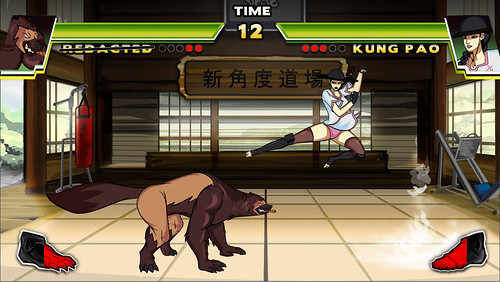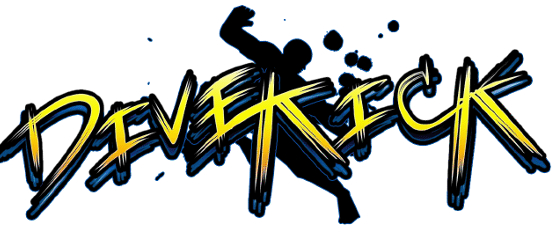Divekick began its life on crowdfunding site Kickstarter, but was quickly picked up by Iron Galaxy and turned into somewhat of a more character rich game. I first noticed Divekick at PAX East 2013: Iron Galaxy was there, showing off the game with custom two button controllers, and a massive crowd waiting to play. Sure enough, the crowd stuck around for the entire convention, and Divekick seemed to sure up its name as something people were taking quite seriously.
Like I alluded to, Divekick is a two button fight game…. Let that sink in a bit, I know I had a hard time wrapping my head around the concept when I first caught wind of the game. While you’re on the ground, one button jumps, the other kicks, if you press the kick button first, you’ll get a back dash. For the most part, it’s that simple.
So how do you create an entire fighting game with just the simple jump and kick? As it turns out, pretty easily. Being a fighting game, Divekick lends itself to being competitive, and with only two buttons anyone can pick it up and at least not be intimidated by the gameplay. With that said, there are a few characters that offer more in terms of strategy for more advanced players, again, bringing more competition and complexity to what could have been something that you could fully understand in five minutes. Adding one more layer of depth is a roster of thirteen characters that somehow all play differently. I don’t know how Iron Galaxy did it, nor do I want to know what voodoo god they prayed to to make a roster that large and diverse happen, but still, it mystifies me.
And that’s the real magic behind Divekick, after a half hour I felt like I could take on anyone without fretting, but after checking out more of the advanced characters, I instantly knew there so much more to learn. It kept me in the game, learning, playing, and most importantly, having a damn good time.

A fighting game in this age wouldn’t be much without fantastic online, and Divekick brings the heat with Good Game Peace Out (GGPO), a net code developed by Tony Cannon, co-founder of Shoryuken. Matches play well, any lag pauses the match and waits for the fight to catch back up. It’s a system designed to provide the most accurate fights possible, and it works.
While using only two buttons during gameplay works well, Iron Galaxy may have decided to stick to that concept a little too much. Moving around the menus tends to suffer and can be a bit slower than it should be. Doing a private game is also a bit more confusing that it should be, because of the two button limit. Instead of just inviting a player, you have to host a private lobby, then have the people you want to join search for one. This doesn’t make the lobby exactly private, as anyone on your friends list can join.
Divekick is cross buy with the PS3, and there is a bit of difference between the two. Like its bigger brother on the PS3, the Vita version of Divekick uses the L1 / R1 for diving and kicking, but they are sometimes a little less responsive than with the older sibling. Also, local versus has its own twist. On the Vita version, each player holds one side of the Vita each, and you choose which of your side of the Vita’s buttons you want to act as dive and kick. So, for example, player one would be up for dive and down for kick, and player two would be triangle for dive, square for kick. Or whatever layout each player wants. Then they both fight on one Vita on the one screen.
Divekick is a game everyone should take a double look at. If you don’t have experience with the genre, this is a great tipping point, just get in, and find out how fun fighting games can be. If you’ve always been worried about doing complex motions, those aren’t present here. Two buttons, that’s all you’ll have to worry about, and that is a liberating feeling.
Anthony Severino contributed to this review.
-
Simple controls
-
Competitive
-
Great online play
-
Menus could be reworked / less confusing








